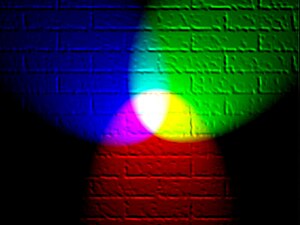Portal:Physics/Selected picture/March 2011
RGB color model[edit]

The RGB color model is an additive color model in which red, green, and blue light are added together in various ways to reproduce a broad array of colors. The name of the model comes from the initials of the three additive primary colors, red, green, and blue.
The main purpose of the RGB color model is for the sensing, representation, and display of images in electronic systems, such as televisions and computers, though it has also been used in conventional photography. Before the electronic age, the RGB color model already had a solid theory behind it, based in human perception of colors.
A common application[edit]

. One common application of the RGB color model is the display of colors on a cathode-ray tube (CRT), liquid-crystal display (LCD), plasma display, or LED display such as a television, a computer’s monitor, or a large scale screen.
Each pixel on the screen is built by driving three small and very close but still separated RGB light sources. At common viewing distance, the separate sources are indistinguishable, which tricks the eye to see a given solid color. All the pixels together arranged in the rectangular screen surface conforms the color image.
